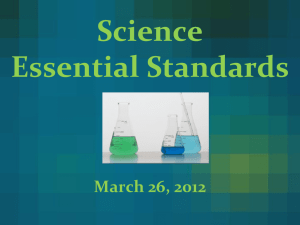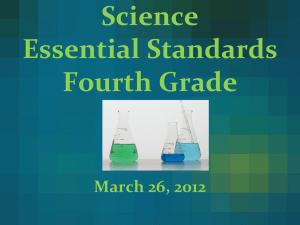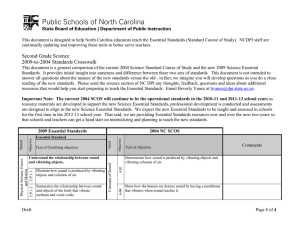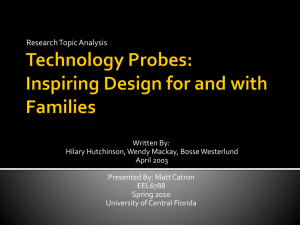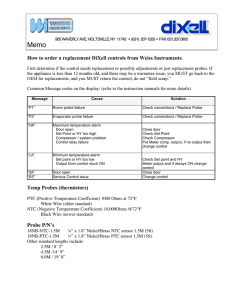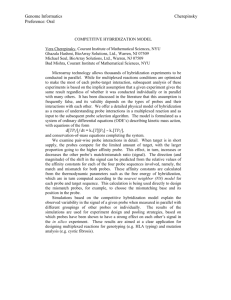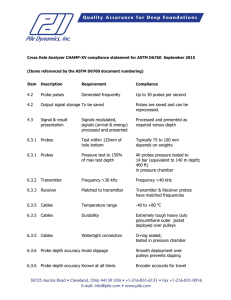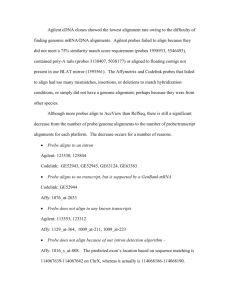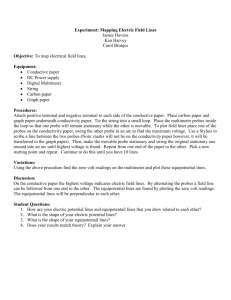Science Team Essential Standards PowerPoint Third Grade
advertisement
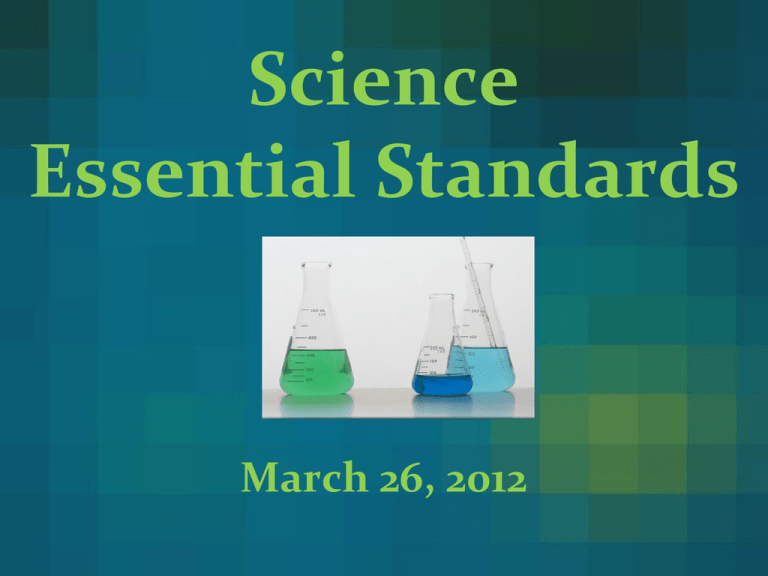
Science Essential Standards March 26, 2012 Part I: Introduction Essential Standards Science Essential Standards 2009 - 2010 Essential Standards Developed & Adopted 2010 – 2011 Current (2004) SCOS Taught & Assessed 2011 - 2012 Current (2004) SCOS Taught & Assessed; Field Tests 2012 – 2013 First Year of Implementation of Essential Standards; New ES Taught & Assessed Understanding the Standards Modules • NC Education https://center.ncsu.edu/nc/login/index.php • North Carolina Essential Standards – Science • Module & Note-Taking Guide Part II: Essential Standards Essential Standards • Organized into 3 strands – Physical Science (P) – Earth Science (E) – Life Science (L) Unifying Concepts • • • • • • • • • Forces and Motion Matter, Properties and Change Energy: Conservation and Transfer Earth Systems, Structures, and Processes Earth History Structures and Functions of Living Organisms Ecosystems Evolution and Genetics Molecular Biology Essential Standards Second Grade: 2.L.1 Understand animal life cycles 2.L.1.1 Summarize the life cycle of animals: • • • • Birth Developing into an adult Reproducing Aging2.and deathLevel Grade L. Strand (Physical, Earth, Life) 2.L.1.2 Compare life cycles of different animals 1. Essential Standard such as, but 2.not limitedObjective to, mealworms, Clarifying ladybugs, crickets, guppies or frogs. Essential Standards • Written using the Revised Bloom’s Taxonomy • Cognitive Process – Verbs used in the standard – Verbs help us understand how to teach and assess the standards Revised Bloom’s Taxonomy • Knowledge Dimension – Ways to categorize the type of knowledge to be learned • • • • Factual Knowledge Conceptual Knowledge Procedural Knowledge Meta-Cognitive Knowledge Essential Standards Second Grade: 2.L.1 Understand animal life cycles 2.L.1.1 Summarize the life cycle of animals: • • • • Birth Developing into an adult Reproducing Aging and death 2.L.1.2 Compare life cycles of different animals such as, but not limited to, mealworms, ladybugs, crickets, guppies or frogs. Essential Standards • Instructional Toolkits – Under development – Include: • Crosswalk documents • Unpacking documents www.ncpublicschools.org/acre/standards/su pport-tools/ Crosswalk Document Unpacking Document Essential Standards Activity • Work together as a team • Determine how the concept of Force and Motion is developed in the Science Essential Standards – How does the concept build and development from Kindergarten to 5th grade? – How are the standards different each year? – Identify the verbs at each grade level. – Determine the big ideas at each grade level. What ideas should students master by 5th grade? Probe #16 Force and Motion Ideas • Let’s think about it. – What do you think our students would say? Part III: Content Knowledge What Students will Come Already Knowing • Compare the position of objects (using positional words)Kindergarten • Explain how push and pull change the motion of an object, effects of force on the motion of an object1st grade 3rd Grade Learning Target • Students know that… – When a force acts on an object it will result in a change of speed and/or direction. – Speed can vary; varying the speed of a moving object will affect the time it takes for the object to travel. – Earth “pulls” on all objects on or near the Earth without touching these objects. Force and Motion Vocabulary Foldable • • • • • Force Motion Speed Gravity Direction Study Jams • http://studyjams.scholastic.com/st udyjams/jams/science/forces-andmotion/force-and-motion.htm Part IV: Classroom Activities Get a Jet Going! Experiment • Follow handout. Let’s Take a Break! • Here’s a neat real life example of the use of force and motion in sports. PBS Teachers — Resources For The Classroom Raceway to Science Experiment • Follow handout. Probe #34 Experiencing Gravity • Let’s think about it. – What do you think our students would say? Hang in There Experiment • Follow handout. Part V: Assessment Probes Formative Assessment Probes • Complete the “Doing Science” probe • Decide which student you agree with and explain your reasoning • Discuss your reasoning with a partner Doing Science Probe • Purpose: – Elicit students’ ideas about scientific investigations • Scientists investigate the world in a variety of ways depending on the question they pose. – Observations, models, experiments, and collecting specimens • There is no fixed sequence of steps that all scientists use and follow rigidly. Suggestions for Instruction • Provide students with a variety of ways to do science • Use caution when using the word experiment (controlling variables); use investigation • Use caution when referring to the scientific method (a scientific method) • Expose students to different types of scientists, areas of science, and science investigations Uncovering Student Ideas in Science • Provide science formative assessment probes • Appropriate for multiple grade levels • Allows teachers to assess students thinking, identify misconceptions, and plan for instruction • Each probe includes “Teacher Notes” & Recommendations Uncovering Student Ideas in Science • Provide science formative assessment probes • 1 set of books per grade level at Title 1 schools • 1 set of books at non-Title 1 schools Part VI: Resources Essential Standards • Instructional Toolkits – Under development – Include: • Crosswalk documents • Unpacking documents www.ncpublicschools.org/acre/standards/su pport-tools/ Essential Standards Resources • DPI Wiki Space http://www.ncdpi.wikispaces.net/ – Webinars – Support Packs – Resources Essential Standards Resources • Science Literacy Maps http://nsdl.org/ • Benchmarks for Science Literacy http://www.project2061.org/publications/bsl/d efault.htm Part VII: Science Test Information Science Tests • Designed for online administration (with paper/pencil version available) • Weight Distributions – – – – – – – Forces and Motion 13–15% Matter: Properties and Change 12–14% Energy: Conservation and Transfer 11–13% Earth Systems, Structures, and Processes 15–17% Structures and Functions of Living Organisms 14–16% Ecosystems 14–16% Evolution and Genetics 13–15% • Types of Items: – Multiple Choice – Technology-Enhanced Items http://www.ncpublicschools.org/acre/assessment/online/
